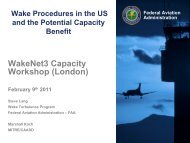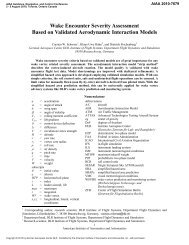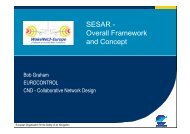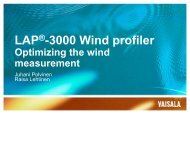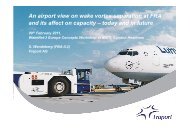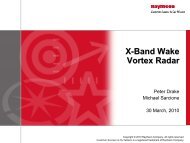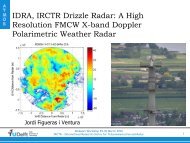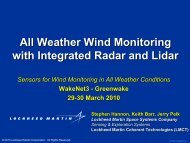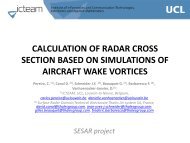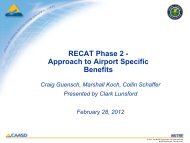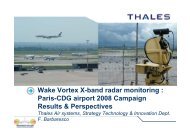Federal Aviation Administration Wake Turbulence Program - WakeNet
Federal Aviation Administration Wake Turbulence Program - WakeNet
Federal Aviation Administration Wake Turbulence Program - WakeNet
You also want an ePaper? Increase the reach of your titles
YUMPU automatically turns print PDFs into web optimized ePapers that Google loves.
<strong>Federal</strong> <strong>Aviation</strong><strong>Administration</strong> <strong>Wake</strong><strong>Turbulence</strong> <strong>Program</strong> -Recent Highlights<strong>Federal</strong> <strong>Aviation</strong><strong>Administration</strong>Jeffery Tittsworth (FAA)Steven Lang * (Volpe)Edward Johnson (FAA)Steve Barnes (FAA – Retired)<strong>Wake</strong>Net-Europe Workshop 201315-16, May 2013STACBonneuil-sur-Marne, France*Presenter 1
<strong>Program</strong> Leadership Redirection‣ Focusing on Operationally Feasible Solutions Using More than WellEstablished <strong>Wake</strong> Science to Date‣ Airport Specific Solutions Instead of Trying to Provide “The Grand UnifiedSolution” (One size does not fit all)‣ Insight that <strong>Wake</strong> <strong>Turbulence</strong> Solutions to the NAS Does Not RevolveSolely on <strong>Wake</strong>s from Heavy Aircraft‣ Phased Approach – Near, Mid to Far Term GoalsHistorical PerspectiveWhat’s Different NowSmall, Stepwise Achievements Defined by the FAA.Focused R&D for Each Specific Defined Goal.Result Has Been a Steady Evolution of Solutions which Increased in Complexity andApplicability as They Were Developed.<strong>Federal</strong> <strong>Aviation</strong><strong>Administration</strong>4
Historical PerspectiveWhat’s Different Now Advancements of Sensor and Information Technologies‣ Smoke Visualization in the 1970s to Long Range and Unattended RemoteSensors in the 2000s (Particularly Pulsed LIDAR – Laser Radar)‣ Statistically Large Amount of Data Collection Now Routine, Including Seasonal and Diurnal Effects Aircraft ID Details Down to Make Model and Series‣ Entire Safety Critical Region Can be Addressed via Direct Measurements Arrival: From Stabilized Approach Point Down to Runway Threshold Departure: From Rotation Point to Point of Divergence<strong>Federal</strong> <strong>Aviation</strong><strong>Administration</strong>5
Historical PerspectiveRoutine/Production <strong>Wake</strong> SensingTower Visualizationand MeasurementsWindlineCW LidarPulsed LidarAircraft SmokeVisualizationAcoustic Radar –Bi-StaticAcoustic Radar –Mono-Static<strong>Federal</strong> <strong>Aviation</strong><strong>Administration</strong>6
Historical PerspectiveWhat’s Different Now Industry/Stakeholder Involvement‣ Safety Management System (SMS) Process – Provides a Rational,Documentable and Repeatable Safety Assessment‣ Periodic Meetings Dedicated to Solicitation of End-User/StakeholderFeedback (Such as <strong>Wake</strong>Net Europe and <strong>Wake</strong>Net USA)<strong>Federal</strong> <strong>Aviation</strong><strong>Administration</strong>7
Highlight Developments in Two Specific AreasClosely-Spaced Parallel Runway <strong>Wake</strong>Separation‣ Arrival‣ DepartureSingle-Runway / In-Trail <strong>Wake</strong> Separation‣ Arrival‣ Departure<strong>Federal</strong> <strong>Aviation</strong><strong>Administration</strong>8
Closely Spaced Parallel Runways (CSPR)Runway Spacing Less Than 2500 Feet/760 Meter20RNP, RNAV, ADS-BBenefit Intended HereNumber ofRunwayPairs1510PRMIndependentApproachesPRM andAngledApproachesIndependentin IMCCurrent<strong>Wake</strong> VortexMinimum forCSPR5DistanceBetweenRunways* Considers Planned Runways04,300 ft** 5 of top 8 delayed airportshave CSPRs < 2500 ft spaced(BOS, PHL, ATL, EWR, SFO)Fort Lauderdale (FLL)Detroit (DTW)Phoenix (PHX)Memphis (MEM)Raleigh Durham (RDU)*Atlanta (ATL)3,400 ftMinneapolis (MSP)Salt Lake City (SLC)Portland (PDX)Dallas Love (DAL)Kennedy (JFK)*Houston (IAH)2 Others3,000 ft*Dulles (IAD)*Seattle (SEA)2 Others2,500 ft1,500 ft** Boston (BOS)Detroit (DTW)Orlando (MCO)*Syracuse (SYR)* Tuscon (TUS)*Cleveland (CLE)4 Others** Philadelphia (PHL)St. Louis (STL)Dallas-Ft. Worth (DFW)Pittsburgh (PIT)** Atlanta (ATL)Las Vegas (LAS)Oakland (OAK)6 Others1,000 ft450 ftMemphis (MEM)Midway (MDW)** Newark (EWR)San Antonio (SAT)Las Vegas (LAS)Houston Hobby (HOU)Los Angeles (LAX)** San Francisco (SFO)Ontario (ONT)San Jose (SJC)Anchorage (ANC)*Miami (MIA)10 Others<strong>Federal</strong> <strong>Aviation</strong><strong>Administration</strong>9
Closely Spaced Parallel Runways (CSPR)Runway Spacing Less Than 2500 Feet/760 MeterThe “2500ft/760m <strong>Wake</strong> <strong>Turbulence</strong> Rule” Effectively Shuts DownOne Runway of the CSPR Pair Under IMC/Marginal VMC2500ft/760m Rule Was Implemented to Protect a Smaller Aircraftfrom <strong>Wake</strong>s of a Heavier AircraftIn Practice, It also Protected a Heavier Aircraft from the <strong>Wake</strong>s of aSmaller Aircraft (unneeded)2500ft/760m Rule Clearly Can be changed for Some Conditions<strong>Federal</strong> <strong>Aviation</strong><strong>Administration</strong>10
Staggered CSPR Arrivals (FAA JO 7110.308)Instrument Procedure for 1.5-nmi Dependent SpacingAircraft #2 Any <strong>Wake</strong> Class AllowedCurrent in-trail separation rules apply after #2< 2500 ftSeparation12L12RWithin-Pair SpacingAt least 1.5 nmiThresholdStaggerAircraft #1 Restrictedto Large or Small wakeclasses for procedureapplication Authorized for 8 major airports Under investigation: 2 additional major airportsNo restriction on winds<strong>Federal</strong> <strong>Aviation</strong><strong>Administration</strong>1111
Staggered CSPR Arrivals (FAA JO 7110.308)Instrument Procedure for 1.5-nmi Dependent Spacing7110.308 Allows Capacity Recovery During IMC/Marginal VMC‣ Airline Scheduling Based on VMCCSPR Operation Safety is Even More Enhanced‣ Long Term <strong>Wake</strong> Data Collection Revealed Enhanced Safety MarginUnder 7110.308 Scenario on the Adjacent CSPRThe Development of 7110.308 Benefited from the DFS ReducedDiagonal Separation Minima (RDSM) and elements of HALS/DTOPEfforts at EDDF‣ Framework of a Relative Safety Assessment‣ Demonstration the Importance of Runway Stagger‣ Importance of the Aircraft Dispersion CharacteristicsThe Development of 7110.308 Benefited Also from NASA’sAirspace Systems <strong>Program</strong> / Efficient Aircraft Spacing Project‣ Extended Coverage of an Experimental Multi-Lateration Flight TrackingSystem<strong>Federal</strong> <strong>Aviation</strong><strong>Administration</strong>12
<strong>Wake</strong> <strong>Turbulence</strong> Mitigation Departure (WTMD)Wind Based CSPR DepartureGoal: Up-wind runway departures notrestricted by down-wind runway departuresNeed: A reliable wind forecast algorithm (WFA)that can predict the WTMD windowsWind Direction1300-ftBefore WTMD:• Wind not considered• For STL geometry shown, Large departing 30L isconsidered an intersection takeoff• Aircraft on 30L has to wait 3 min after Heavydeparts 30R• 2 min wait required when stagger is less than 500 ft Operational Demo at SFO, IAH & MEM Potential Implementation at 10Airports After Operational Demo30L1500 ft30RWeather Minima• Sufficient to visually observe divergent pathsafter departure• Approximate 1000’ ceiling and 3 mile visibility<strong>Federal</strong> <strong>Aviation</strong><strong>Administration</strong>13
<strong>Wake</strong> <strong>Turbulence</strong> Mitigation Departure (WTMD)Wind Based CSPR Departurehttp://www.aviationweek.com/awin/ArticlesStory.aspx?keyWord=WTMD&id=/article-xml/avd_05_13_2013_p03-01-577876.xml<strong>Federal</strong> <strong>Aviation</strong><strong>Administration</strong>14
<strong>Wake</strong> <strong>Turbulence</strong> Mitigation Departure (WTMD)Wind Based CSPR Departure Capitalized on International and Inter-Agency Collaboration• WFA is a modification to one developed for the <strong>Wake</strong> Vortex WarningSystem (WVWS) for DFS Deutsche Flugsicherung GmbH by DLR• Data collected in a joint effort with EUROCONTROL at FRA/EDDF intheir pursuit of a wind dependent single runway wake mitigation solutioncalled the Crosswind Reduced Separations for Departure (CREDOS)project.• Although an FAA NextGen deliverable, NASA partnered with the FAA,with the NASA role being the development and assessment of a nonoperationalprototype.<strong>Federal</strong> <strong>Aviation</strong><strong>Administration</strong>15
<strong>Wake</strong> <strong>Turbulence</strong> Mitigation Departure (WTMD)Wind Based CSPR Departure The first automation driven wake separation change that allowsdynamic separation based on meteorology and aircraft category Improves capacity under visual meteorological conditions Safety of the aircraft operating on the wake free runway is enhancedeven further than pre-WTMD’s CSPR operation Scientifically, it illustrates that short term wind nowcasting hasbecome far more matured than previously realized<strong>Federal</strong> <strong>Aviation</strong><strong>Administration</strong>16
<strong>Wake</strong> <strong>Turbulence</strong> Recategoriztion – RECAT IExamples on Why Some <strong>Wake</strong> Separations Can be Safely Reduced“Status Quo”<strong>Federal</strong> <strong>Aviation</strong><strong>Administration</strong>17
<strong>Wake</strong> <strong>Turbulence</strong> Recategoriztion – RECAT IExamples on Why Some <strong>Wake</strong> Separations Can be Safely Reduced2.5 NMSpacing Can be Safely Reduced For Bottom Pair to Less than 4 NM<strong>Federal</strong> <strong>Aviation</strong><strong>Administration</strong>18
<strong>Wake</strong> <strong>Turbulence</strong> Recategoriztion – RECAT I RECAT is a Three-Phase Approach: RECAT I: Collaborative Effort Between FAA and EUROCONTROL <strong>Wake</strong> Data Sharing (LHR 1 , CDG 2 , FRA 3 , SFO 4 , JFK 5 , MEM 6 , DFW 7 ) Exchange of <strong>Wake</strong> Data Analysis Expertise Exchange of ATM / Operational Expertise Exchange of Safety Assessment Expertise RECAT I: Within a Static <strong>Wake</strong> Separation Minima Framework,Change from a MTOW Based Standard to a <strong>Wake</strong> Based Standard Split the Heavy Category into Super, Upper and Lower Heavies Placed Additional Safety Buffer to Further Protect the FAA Lower EndSmall or ICAO Light Aircraft Followers1 TBS ; 2 WIDAO ; 3 CREDOS ; 4 SOIA ; 5 FAA-NASA R&D; 6 NASAAVOSS ; 7 NASA AVOSS<strong>Federal</strong> <strong>Aviation</strong><strong>Administration</strong>19
<strong>Wake</strong> <strong>Turbulence</strong> Recategoriztion – RECAT I RECAT is a Three-Phase Approach: RECAT I: Global Harmonization for a Static Six Category Based System RECAT II: Global Harmonization for a Set of Static Pair-Wise <strong>Wake</strong>Separation Minima Standards RECAT II: Individual ANSPs Can Then Optimize the Categories fromthe Static Pair-Wise <strong>Wake</strong> Separation Minima RECAT III: Dynamic Pair-Wise <strong>Wake</strong> Separation MinimaMeteorology, Aircraft Parameters, Aircraft Trajectory/NavigationBased<strong>Federal</strong> <strong>Aviation</strong><strong>Administration</strong>20
<strong>Wake</strong> <strong>Turbulence</strong> Recategoriztion – RECAT IStatus and Ongoing PlanMemphis (MEM) Became the Key Site to Adopt RECAT Phase I<strong>Wake</strong> Separation Spacing Prior to NAS roll out (November 1, 2012FAA JO 7110.608)MEM Lessons Learned (automation, training, more representativematrices to measure RECAT I impact, etc.) Will be Incorporated atSubsequent Airport ImplementationsPhase II Activities Ongoing‣ FAA and EUROCONTROL Jointly executing the R&D with othercontributors and partners‣ Stakeholder Inputs/Contributions being solicited<strong>Federal</strong> <strong>Aviation</strong><strong>Administration</strong>21
Other <strong>Wake</strong> <strong>Program</strong> Activities / Deliverables A380, B747-8 and B787‣ Established the Appropriate ICAO <strong>Wake</strong> Spacing for TheseAircraft with International Partners (EUROCONTROL, EASA,ICAO, Airframe Manufacturers) B757 Harmonization‣ Harmonized the Separation Spacing for All Three Variants of theB757 in the US Jet Blast at JFK‣ Not a <strong>Wake</strong> <strong>Turbulence</strong> Issue, But Demonstrated that <strong>Wake</strong><strong>Turbulence</strong> Separation Applied at JFK for Intercepting RunwayGeometry was Not Necessary‣ Improved Efficiency for Intercepting Runways<strong>Federal</strong> <strong>Aviation</strong><strong>Administration</strong>22
Closing Remarks FAA <strong>Wake</strong> <strong>Turbulence</strong> R&D Has Come a Long WaySince 1970s (or Even 2001)‣ FAA <strong>Wake</strong> Investment is Contributing to Positive Operational Impacts‣ Safely and Efficiently Enabling NextGen’s Overall Goal to Reduce Delays,Enhance Operational Efficiency and Capacity Improvements‣ Reduced Emission, Although not a <strong>Wake</strong> <strong>Program</strong> Deliverable, Became aBi-Product‣ Benefited Significantly from International Collaboration Inter-Agency Collaboration Advances in Sensors and Information Technologies SMS Process Stakeholder Engagement<strong>Federal</strong> <strong>Aviation</strong><strong>Administration</strong>23
Moving Forward <strong>Wake</strong> <strong>Turbulence</strong> solutions are not solely a US or EUconcern, rather a Global <strong>Aviation</strong> concern For the Global Success / Impact‣ Manufacturers have a role in providing aircraft performance data‣ Researchers have a role in developing proposed changes that areoperationally achievable‣ Airlines and other Operators have a role in describing the importance ofan operational change and acting as an advocate‣ Regulators have the role of assessing the safety of a proposed change‣ ANSPs have the role of implementation of the proposed change in anacceptably safe manner<strong>Federal</strong> <strong>Aviation</strong><strong>Administration</strong>24
Additional InformationTittsworth, Lang, Johnson and Barnes, “<strong>Federal</strong> <strong>Aviation</strong><strong>Administration</strong> <strong>Wake</strong> <strong>Turbulence</strong> <strong>Program</strong> - RecentHighlights,” presented at the 57 th Air Traffic ControlAssociation (ATCA) Annual Conference & Exposition,October 2012<strong>Federal</strong> <strong>Aviation</strong><strong>Administration</strong>25
Questions?<strong>Federal</strong> <strong>Aviation</strong><strong>Administration</strong>26



